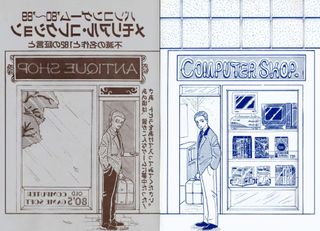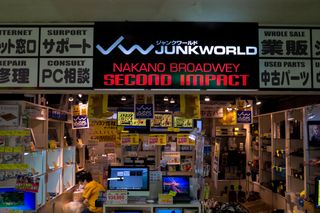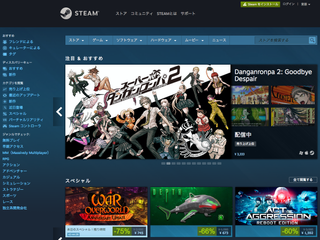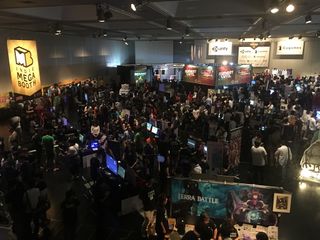How Japan learned to love PC gaming again
Since 2010, Japan has embraced the PC. Developers talk about the challenges they overcame to make it happen.

Challenge: The gaming PC is an arcane machine in Japan
From the 80s to the mid-90s, Japan enjoyed a now mostly forgotten golden age of PC gaming, with thousands of games for computers like the Fujitsu FM Towns and NEC PC-9801. High resolution screens and specialized hardware made Japanese PCs ideal for visual novels with lots of text. So where did they all go? Cheap IBM-compatible PCs started to hurt Japanese system sales in the early 90s, and Windows 95, which didn't need special hardware to properly render Japanese text, sealed their fate. The legacy of visual novels continued on Japanese PCs, now running Windows, but as the domestic PC market died nearly everything else moved to the more popular consoles.
"There’s two kinds of genres on PC from a Japanese perspective," said Esteban Salazar. "Tiny, tiny fan made games that are often visual novels with a lot of 2D character portraits and a lot of talking, which sell like 300-400 units in packages in places like Akihabara and Den-Den Town. Very niche, very hardcore otaku-oriented titles. And there are also western PC titles, which are also in Japan very niche. There’s a certain audience that enjoys them but the prices are extremely high. You’ll see something like Call of Duty, and it runs about 30 or 40 dollars higher than it does in the United States. Even when you go to an import store, you’ll see boxed copies of old games like Age of Empires 2 for like 60 dollars, still. People are willing to pay it, but it’s still a very small audience."
Even if you have a PC at your house, you're more likely to use some sort of tax program or write your New Years cards on it.
Esteban Salazar, Marvelous
90s PC gaming was already a small audience compared to consoles in Japan, but in recent years both have taken a big hit from mobile. For console developers, that means more money going towards the development of mobile 'gacha' games that earn millions of dollars per month. But for the PC, the rise of mobile means… well, basically, what PC?
Everyone in Japan I spoke with said the same thing: most people don't have PCs in their home. The average family owns smartphones, and maybe a tablet. "Even if you have a PC at your house, you're more likely to use some sort of tax program or write your New Years cards on it," Salazar said.
Zach Huntley, who runs a small publishing support company in Japan called Kakehashi Games, said that teens and those in the 20-40 age bracket often have laptops, but that laptop is more than likely a MacBook, or is meant for business, not gaming. "This very small band of people have laptops, and this very, very small band of people have desktop PCs that are capable of playing 3D games. The thing is that those people who do have the desktop PCs and play on Steam, they have it specifically because they want to play western games. People aren't building super desktop PCs to play a 3D Japanese game, necessarily, on Steam. If they want to play Dark Souls 3, they're going to play it on PS4. They're building their PC rig specifically because they want to play the cool western stuff that's not coming out on any other platform."

Even within those confines, Huntley has found a way to grow a business helping Western indie developers translate and self-publish their games in Japan. He's on track to help release 40 games on Steam this year, including all of Devolver Digital's; he recently assisted Thumper and Salt & Sanctuary's devs release in Japan. While Japanese games find more and more success in the West, it's actually western games growing the much smaller PC market in Japan.
"One bit of anecdotal evidence for the Japanese market is that generally whenever we localize a game into Japanese for Steam, Japan will jump up into the top five of their countries worldwide," he said. "So obviously that kind of shows the importance of the localization. But there is a pretty steep drop off after those first few countries, once you get past the United States and Russia, stuff like that. Once you get past, say, 3 or 4, there is a pretty significant drop. But to get Japan up into that area, it proves it is a relatively strong market."
PC Gamer Newsletter
Sign up to get the best content of the week, and great gaming deals, as picked by the editors.
Japan's PC market is small, then, but stronger than you might think. According to Steam's traffic data, Japan accounts for 1.2 percent of global downloads, compared to 1.9 percent for South Korea, 1.8 percent for Australia and 2.4 percent for Canada. The US guzzles down 17.5 percent of Steam downloads. And despite some competitors like Playism, it really is the platform, even in Japan. Huntley says games will sell 100 times more on Steam than other stores.
Until recently, that's actually been a big obstacle, because Steam wasn't built to support Japanese games or money.

Challenge: Steam still isn't that easy for developers to use in Japan
Navigate to Steampowered.com from a Japanese IP address and you'll see some Japanese games on the store. You'll also see an entire screen full of English text—about as inviting for a Japanese native as it would be for me to open Steam to a screen full of katakana.
"Steam was initially a platform where they did very minimal localization," said Ben Judd. "It honestly wasn't that good. They basically tried Microsoft's original Xbox way of releasing games. Microsoft at the time was like, 'hey, play these western games in English, it'll be a great way to study English,' because they didn't want to take a hit on the Japanese localization and make the title unprofitable, but they did want to release it. Unfortunately Japan is a country in which localization, having it in their language, definitely helps sales."
But things have gotten better. Japanese is one of many language options that translates most of the store, although thumbnails and game names are still in English, and some games don't include Japanese descriptive text. In August 2014, Valve added yen as a currency to the Steam store. Most of the developer information is now also available in Japanese, but it's still not practical to use Steam without decent English skills.
According to indie developer Alvin Phu, who moved from Boston to Tokyo to start a small studio, the financial section of Steam's developer dashboard is still in English. And Japanese developers who have no contacts at Valve rely on Greenlight to get their games on Steam, which likely requires writing an English description.
"There's always going to be the language barrier. That's always going to be number one," Zach Huntley said. "For a Japanese indie to communicate with Valve, good luck. That's going to be hard. There's no denying one of the huge success stories to come out of Japan, Downwell, Ojiro-san happens to speak great English. It doesn't take a genius to put two and two together there, right?"

Challenge: Japan's indie scene is still small and deeply counter-cultural
In the West, independent development has been on the rise for a solid decade, spurred on by early successes like Braid and Super Meat Boy. In Japan, the 'scene' is still in its infancy, struggling for the recognition and success of Western indies, for reasons practical and deeply cultural.
Alvin Phu runs a Tokyo indie meetup where discussion often turns to how to get a game released in the West. Again, there's that language barrier, and most Japanese PC gamers have PCs to play western games, not domestic ones. Everyone I spoke with had different points to make about how tough it is for indies to make it in Japan.
Some of it is simply geographical, Phu said. In the US, game developers are spread out across the country, and if you quit a job you may have to choose between a big move or striking out as an indie. In Japan, you can leave a job at one game developer in Osaka or Tokyo and walk across the street to another one.
But leaving a job, period, is still uncommon. "I think the lack of the indie scene in Japan is so much more a deeply cultural issue than it is anything else," Zach Huntley said. "Japanese people, they're kind of taught you go to school, you get a job, you stay at that same company until you retire, you're done. There is an entrepreneurial spirit here, but it's really off to the side... Right now, the indie scene in Japan is either people who were 20-plus year triple-A veterans who are like, 'Fuck it, I've had enough, I've made enough money, I can support myself, I'm going to do my own thing.' Or you have these kids who didn't even go to college for games. They just dig games and are just hobbying, doing it on the side, and maybe they strike gold and end up coming across a good idea. And they end up making just enough money to survive. But that middle ground, where it's people who've spent a few years in a studio and say, 'Screw it, I'm going to try to make an indie game and if it doesn't work I'll just get another job'? That doesn't happen."
Japan does have a history of amateur game development with doujin games like Touhou Project, but these are personal hobby games that are rarely sold. Companies like Carpe Fulgur and Playism have helped bring some of these games West, but they remain, in general, a small and obscure corner of gaming, even in Japan. When doujin games are sold in Japan, it's usually a few hundred copies on DVDs at a weekend comic market, not on a platform like Steam. That ties into another problem: buying games digitally in Japan is still way behind where it is in the US. Enter 7-Eleven.
Challenge: Japan doesn't do credit cards
You can get a credit card in Japan, but good luck using it. Cash still reigns supreme, and even if a store takes credit cards, Huntley joked that you should expect five receipts covered in stamps. Worse, he says most bank cards won't let you make purchases online.
"My Japanese credit card is actually more like a debit card," Ben Judd said. "They don't let you charge more than what's in your bank account ever. It's the first card, probably on any worldwide credit card list, that's going to be stopped if you try to use it in a foreign country, or if you go to a website for the first time. It's a major hassle, but they're all about security."
A few years ago, buying games on Steam was an insanely elaborate process: 'buying' the game online, taking an email verification code to a convenience store, entering that code into a touchscreen kiosk to print out a receipt, taking that receipt to the cashier, and paying. Then you could walk home and download your game. Imagine going through that much effort every time you wanted to buy a game on Steam.
Now there's a much better option—7-Elevens and other stores carry Steam wallet cards, alongside the stacks of points cards for mobile games, iTunes, and Google Play. But you still have to go to the store to stock up on digital currency. Is it any wonder physical music sales are still massive in Japan while digital media sales lag behind the rest of the world? "I think that impulse buy, it's hard to get that in Japan," Huntley said.

Challenge: Japanese people may be more susceptible to motion sickness
It's hard to imagine PC gaming—Western gaming in general, really—without the first-person shooter. 600,000 people play CS:GO every day. Doom is one of the most influential games ever. But the genre has never really taken off in Japan. Even with unusually strong Japanese support, the Xbox 360 console only sold 1.6 million consoles in its lifetime, and that era was arguably the peak for big budget shooters. Japan does have its hardcore western games who own PCs to play western games, but aside from general cultural tastes, there's another possible reason first-person shooters never really took off in Japan: there's a better chance they'll make people nauseous.
"Japanese people have a genetic predisposition to motion sickness," said Huntley. "That's why most Japanese games actually don't let you control the camera. It's why they don't play first person games, really, in Japan. Actually, a lot of people will actually take motion sickness pills before playing a VR game. That's how hardcore they are. They want to enjoy it, even though they know they're going to get sick. They buy pills just so they can play the game. Anything camera related, that can make anybody feel remotely queasy, that's just a no-go for Japan."
Judd made the same comment about Japanese gamers, and there are studies that confirm a connection between ethnic background and motion sickness. Even the producer of Mario Galaxy cited it as a common issue. That may have been a small contributing factor in the grand scheme of PC shooters never sweeping Japan the way Doom swept the US, but every little hit chips away at the gap between the evolution of PC gaming.

Looking ahead
In 2017, XSeed brought more of the Legend of Heroes games to Steam, continuing to put some of the most celebrated PC JRPGs ever made in front of new audiences. Sega began making more PC ports of its older games, with even more in the works. At this point, there are still a few whales Japanese game fans are campaigning for, like Atlus's Persona 5. But it feels like only a matter of time.
Though no one I spoke with expects the PC audience at home in Japan to grow in any significant way over the next few years, there is another audience growing that may spur even more PC ports of Japanese games: China. Steam was at one point blocked in China, but now it represents 10 percent of Steam's global traffic, second only to the United States. Lars Doucet, the developer of Defender's Quest, recently wrote about the big payoff of localizing a game for China. Soon Japanese PC games may stand to earn nearly as much from China as they do for the west, a boon to indie developers and studios porting big games alike.
"The fact that indies can publish, and the fact that the multiplatform costs have come way down from engines that cover all these options, to just the actual [PC development] work itself being much easier." said Ben Judd. "Why would you not, is the question?"

Wes has been covering games and hardware for more than 10 years, first at tech sites like The Wirecutter and Tested before joining the PC Gamer team in 2014. Wes plays a little bit of everything, but he'll always jump at the chance to cover emulation and Japanese games.
When he's not obsessively optimizing and re-optimizing a tangle of conveyor belts in Satisfactory (it's really becoming a problem), he's probably playing a 20-year-old Final Fantasy or some opaque ASCII roguelike. With a focus on writing and editing features, he seeks out personal stories and in-depth histories from the corners of PC gaming and its niche communities. 50% pizza by volume (deep dish, to be specific).
Most Popular

